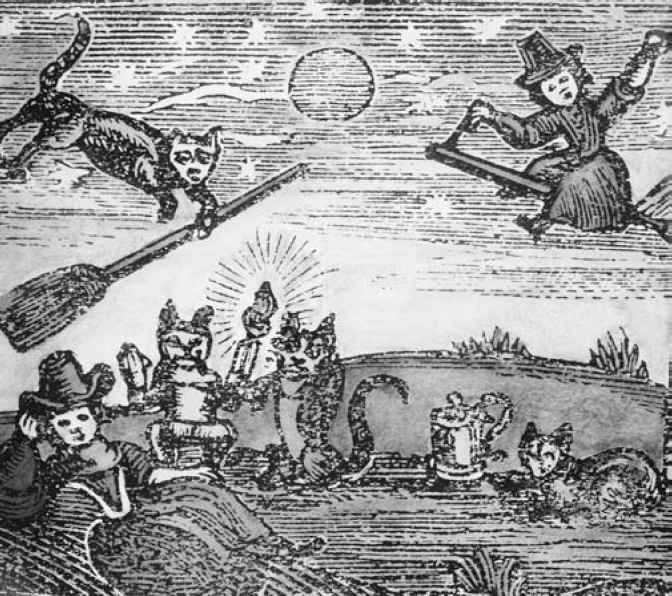In 1597, Aberdeenshire woman Ellen Gray was accused of using sorcery, witchcraft, and charms on farm worker Thomas Reddoch “so that his wand nevir lay doune”. Thomas apparently later died from his condition.

In 1597, Aberdeenshire woman Ellen Gray was accused of using sorcery, witchcraft, and charms on farm worker Thomas Reddoch “so that his wand nevir lay doune”. Thomas apparently later died from his condition.

Traditionally in Strathspey, A witch had 5 options for transformation, depending on what they had to do that day. A hare, A cat, A raven, A magpie, or a medium-sized flattish stone.

A Stone: The witch is supposed to transform into a stone and wiggle into the ground right in the path of the farmer’s plough. This causes a jam between the coulter (4) and the sock (5) and makes the plough skid above the surface, leaving a patch of fallow soil called the bauk.

The other roles explained:
A hare: for sneaking around the farm and fields.
A cat: for getting access into people’s homes.
A raven: for travelling long distances (like to conferences, demonic AGMs etc.)
A magpie: for nipping round to a friend’s house to talk witchy stuff.
Sarah Dalrymple, Countess of Dumfries (1654-1744) was said to have had suffered from a “distemper” that caused her to fly across the room and around the garden. Was it witchcraft? None could say. Was she definitely 100% flying about? Robert Wodrow was absolutely certain.


That Sarah could fly was apparently common knowledge at the time and after her death. In a pasquil (a satirical poem) lampooning the Stairs family, a poet had this to say about her:
The airie fiend, for Stairs hath land in Air,
verse from “Satyre on the Familie of Stairs”
Possess another daughter for ther share,
Who, without wings, can with her rumple flye.
No middling-foull did ever mount so high;
Can skip o’er mountains, and o’er steiples soare,
A way to petticoats ne’re known before.
Her flight’s not useless, though she nothing catch;
She’s good for letters when they neid despatch.
When doors and windows shutt, cage her at home,
She’le play the shittlecock through all the roume,
This high flown lady never trades a stair,
To mount her wyse Lord’s castles in the air–
Maidment, J. (ed) (1868) A Book of Scotish Pasquils 1568-1715 [sic]. William Paterson, Edinburgh. pg.179
Wodrow, R. (1842) Analecta: or, Materials for a history of remarckable providences; mostly relating to Scotch ministers and Christians. Vol. 2. Maitland Club, Glasgow pg.4
Thank you to @Flitcraft for letting me know about the pasquil.
v. to transfer milk from a neighbour’s cow to another by magic. Spells were cast using a tether made from a human hair rope. A skill believed to be held by witches and Highlanders.

Dictionary of the Scots Language. https://dsl.ac.uk/entry/snd/milk
John Fian, executed 1591, was said to have accidentally seduced a cow instead of a young woman he liked. He asked her brother to get “her private hairs” for a spell, but her mother (being a witch also) gave him hair from an udder instead. Sorcerer no, perv yes.

In February 1597, Aberdeen women Johnnet Wischart and Issobell Cockie were accused of witchcraft and sentenced to death. Aberdeen invoiced them for their own burning. They were also billed for the burial of their “accomplice”, Issobell Mantheith.

From what I can tell from the burgh record extracts, Issobell, Johnnet, and Johnnet’s son Thomas Leyis were named “ringleaders” in group conviction of witches and the three of them were sent bills as they were able to pay. Others were already dead or unable to pay. Issobell Mantheith had hanged herself in prison before she could be executed.

It looks like the whole Leyis family were an unpopular one as they (7 of them) plus 3 complices were executed or banished. The Survey of Scottish Witchcraft says doesn’t mention strangulation, just that they were burnt. (Women convicted of witchcraft were usually strangled before being cremated, but in 1597, they seem to have been burnt alive).
UPDATE: I’m sure a historian of witch trials in Scotland could say much more about how common it was to be invoiced for your own death, but I found some more examples of “receipts” in the Annals of Pittenweem for the 1640s.
3d Nov. 1643. — John Dawson has made payment of his grassmail, and of the soume of £40, expenses depursit upon executing his wyff, to the treasurer.
18th Dec. 1643 –Thomas Cook, son to Margaret Horsbrugh, is ordainit to pay three score of punds for expenses debursit on the executing of his said mother for witchcraft.
12th Jan 1644.– Archibald and Thomas Wanderson are decerned to pay the soumes of ane hundredth marks for defraying of the charges depursit upon their wives, execut for witchcraft.
Cook, D. (ed.) (1867) Annals of Pittenweem : being notes and extracts from the ancient records of that burgh, 1526-1793. pp.49-50
In 1720, the Baron of Calder’s son convinced everyone he’d been possessed, claiming he could pee ink, fly around the room, teleport to Torryburn, and could sleep through being horsewhipped (folk tested). 5 women rounded up- all got off with a mild rebuke.

In 1704, one of the “Pittenweem Witches” Beatrix Layng met the devil on Ceres Moor. She knew because he appeared as a black dog. This is Ceres Moor today, and my pup, Scout. She is rarely a devil. Layng denied being a witch, but adamant she had been chatting with Satan himself. Layng was released from prison after paying £8 and eventually pardoned by Queen Anne in 1708.

Locharbriggs, north of Dumfries was traditionally the trysting place for all witches and warlocks in the area. The meetings were so terrifying and memorable for the locals they were used to tell folks’ age (I’m older than Tibbie Fleucher’s Hallowmass tryst).

